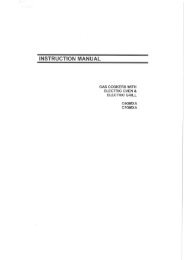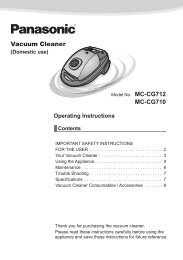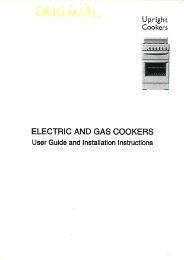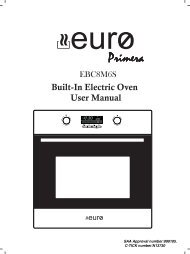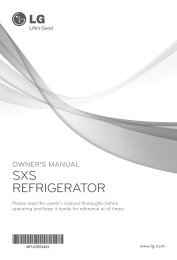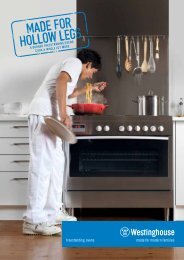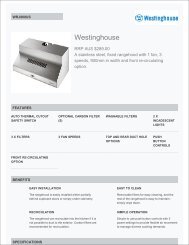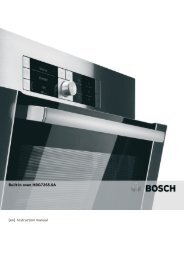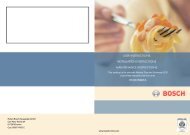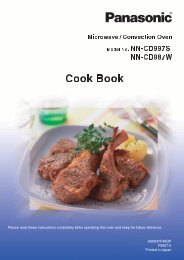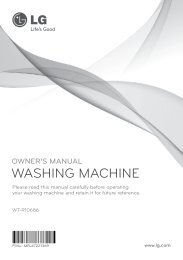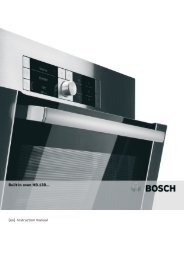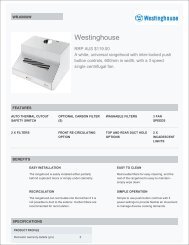Panasonic NN-ST671S 32Litre Microwave User Manual Download
Panasonic NN-ST671S 32Litre Microwave User Manual Download
Panasonic NN-ST671S 32Litre Microwave User Manual Download
Create successful ePaper yourself
Turn your PDF publications into a flip-book with our unique Google optimized e-Paper software.
<strong>Microwave</strong>s penetrate the surface of the food to a<br />
depth of about two to three centimetres and then<br />
the heat is gradually conducted in a random pattern.<br />
Some parts of food matter cook faster than others.<br />
Special microwave techniques are used to promote<br />
fast and even cooking. Some of these techniques<br />
are similar to those used in conventional cooking, but<br />
because microwaves produce heat very quickly the<br />
following techniques are extremely important. It’s a<br />
must for you to be familiar with the following tips.<br />
Food Characteristics<br />
Size and Quantity<br />
Small portions cook faster than large portions.<br />
As you increase the quantity of food you put into<br />
the microwave oven, you must also increase your<br />
cooking time. The microwave oven has the same<br />
power regardless of quantity; thus the power is<br />
divided between more items and so it takes longer to<br />
cook. As a general guide, if you double the quantity<br />
of food suggested in the recipe, add half the time<br />
suggested again.<br />
Liquid Content<br />
Low moisture foods take a shorter time to cook than<br />
foods with a lot of moisture.<br />
Shape<br />
Uniform sizes cook more evenly. To compensate<br />
for irregular shapes, place thin pieces towards the<br />
centre of the dish and thicker pieces towards the<br />
outer edge of the dish.<br />
Bone and Fat<br />
Bones conduct heat and cause the meat next to<br />
them to be heated more quickly. Large amounts of<br />
fat absorb microwave energy and the meat next to<br />
these areas may overcook.<br />
Starting Temperature<br />
Food which has been sitting at room temperature<br />
takes less time to cook than refrigerated or frozen<br />
food.<br />
Density and Composition<br />
Porous, airy foods (cakes and breads) take less<br />
time to cook than heavy compacted foods (meat and<br />
vegetables). Recipes high in fat and sugar content<br />
cook more quickly.<br />
Techniques for Preparation<br />
Timing<br />
A range of cooking times is given in each recipe for<br />
two reasons. First, to allow for the uncontrollable<br />
differences in food shapes, starting temperatures and<br />
personal preferences. Secondly, these allow for the<br />
differences in electrical voltage input which changes<br />
during peak load periods. Always remember that it<br />
is easier to add time to undercooked food. Once the<br />
food is overcooked, nothing can be done. For each<br />
recipe, an approximate cooking time is given.<br />
Stirring<br />
Stirring is often necessary during microwave cooking.<br />
We have noted when stirring is helpful in the recipes.<br />
Always bring the outside edges towards the centre<br />
and the centre portions to the outside.<br />
Rearranging or Turning<br />
Some foods should be turned in the container during<br />
cooking. For example, because of the different<br />
thicknesses in the breast and back sections of<br />
poultry, it is a good idea to turn poultry over once to<br />
ensure more even cooking.<br />
Rearranging or turning over uneven shaped food in<br />
the dish should be done as suggested to ensure a<br />
satisfactory result. Rearrange small items such as<br />
chicken pieces, prawns, hamburger patties, nuts or<br />
potatoes. Rearrange pieces from the centre to the<br />
edge of the dish.<br />
Cooking in Layers<br />
This microwave oven is not designed to cook more<br />
than 1 layer of food. Cooking in 2 layers may not<br />
always be successful, it takes longer and may be<br />
uneven. You can successfully reheat two dinner plates<br />
of food at one time but remember to increase the<br />
reheating time and use a microwave warming rack.<br />
Piercing of Foods<br />
Pierce the skin or membrane of foods such as eggs,<br />
tomatoes and jacket potatoes when cooked whole in<br />
the microwave oven. This allows steam to escape. If<br />
the skin has not been pierced, food may burst.<br />
<strong>Microwave</strong> Recipe Techniques<br />
Cured Meats<br />
Cured meats may overcook in some areas due to<br />
the high concentration of salts used in the curing<br />
process. So take care when cooking different brands<br />
of bacon as cooking times may vary slightly.<br />
– 21 –



